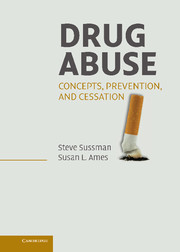Book contents
- Frontmatter
- Contents
- Preface
- Acknowledgments
- SECTION ONE CONCEPTS AND CLASSES OF DRUGS
- SECTION TWO ETIOLOGY
- SECTION THREE PREVENTION
- SECTION FOUR CESSATION
- 15 Concepts of Cessation
- 16 Neurobiologically Relevant
- 17 Cognitive Processes
- 18 Social Interaction and Social Groups
- 19 The Large Social and Physical Environment
- SECTION FIVE CONCLUSIONS AND THE FUTURE
- References
- Author Index
- Subject Index
19 - The Large Social and Physical Environment
Published online by Cambridge University Press: 18 December 2009
- Frontmatter
- Contents
- Preface
- Acknowledgments
- SECTION ONE CONCEPTS AND CLASSES OF DRUGS
- SECTION TWO ETIOLOGY
- SECTION THREE PREVENTION
- SECTION FOUR CESSATION
- 15 Concepts of Cessation
- 16 Neurobiologically Relevant
- 17 Cognitive Processes
- 18 Social Interaction and Social Groups
- 19 The Large Social and Physical Environment
- SECTION FIVE CONCLUSIONS AND THE FUTURE
- References
- Author Index
- Subject Index
Summary
This chapter describes larger social and physical environments that provide access channels to substance misuse treatment and may minimize negative consequences to the individual and others in the systems with whom he or she interacts. Macro-level systems (e.g., work environments, schools, and community housing, with their physical and social characteristics) suffer from or address the problems and costs associated with substance misuse. For example, drug misuse may result in a variety of urban environmental stressors, including violence, vandalism, and deteriorating housing, and vice versa, urban stressors may perpetuate the use of drugs as a means of coping with these environmental stressors (e.g., Galea, Ahern, & Vlahov, 2003). Modification of urban environments and introduction of social services attempt to ameliorate substance abuse problems.
As a second example, substance misuse impedes productivity of workers and can result in absenteeism, drug-related illnesses and injuries, increased health care expenditures, low employee morale, theft, and premature death (Sussman & Ames, 2001). In addition, costs of drug abuse are associated with various drug-related crimes, incarceration, and lost production due to drug-related crime careers and correctional services. Worksite and penal systems have implemented means to assist in the cessation of substance abuse.
Drug abuse is a public health problem that needs to be addressed by larger systems. The drug abuser may reach treatment systems through a variety of channels – for example, as a comatose or psychotic patient at a hospital, an employee who is having work relationship problems, or the perpetrator of a crime to obtain money for drugs.
- Type
- Chapter
- Information
- Drug AbuseConcepts, Prevention, and Cessation, pp. 262 - 274Publisher: Cambridge University PressPrint publication year: 2008

